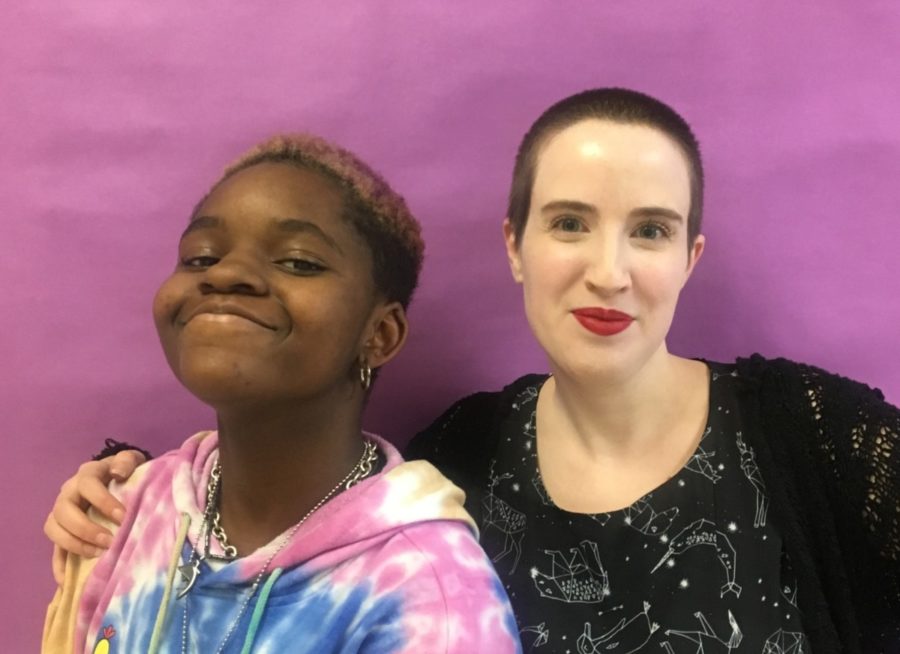New Ways for Community Building Among LGBT Teens
A Matter of Pride: Teacher Amy Shilling and sophomore Andrew Weeks are part of the LGBT community at North Atlanta.
When watching the fledgling queer youths go about their lives — the more expressive of the bunch sporting oh-so-trendy undercuts and purple galaxy dyed hair — it is easy to forget that things were not always this way.
The LGBT teens of yesteryear did not obtain their jokes from Gay Twitter and they certainly did not have the privilege of decorating their person with any number of pride flags in a valiant attempt at self expression. In fact, growing up LGBT, for many Gen Xers and Baby Boomers, was a rather frightening experience. Sexualities and forms of gender identity that strayed from the traditionally accepted heterosexual, cisgendered model were often met with violent retaliation.
For French teacher Robin Oliver, who spent his adolescence in a British military boarding school, he wouldn’t have dared admit his sexuality, even to himself. “Being gay or lesbian was the worst possible thing to be. It would have been social death,” said Oliver.
Another French teacher, Phillipe Maury, was very fortunate to have grown up in such an accepting environment, however, he acknowledges that, even for him, things were not perfect. “I think the greatest issue in the 70s was being confined to bars and restaurants. You could be open in private but you couldn’t really come out in public,” he said. “Nowadays being gay is like being lefthanded, and just another part of life.”
And for the most part, this is true. Growing up LGBT is not the underground indie film it once was. It is not uncommon to find LGBT representation in the media in far more shapes and sizes than before. Less often are gay characters confined to accessorizing the lives of shopping obsessed teen girls, and their stories no longer revolve completely around their queerness. That being said, there is still ample room for improvement, especially when it comes to transgender representation. However, despite this, it is obvious that where the media age is lacking in satisfactory representation, it makes up for in being a hub for connections.
The Internet has played a particularly integral role in cultivating a sense of community among current LGBT youth. With social media platforms like Tumblr, Twitter and Instagram, queer youth have been able to find other LGBT teens, a luxury not afforded to past generations. Not only is the internet creating cyber connections, but it is linking people across the country with Queer Prom, Homoween, and Pride. “I think the internet has created a safe space. It has assisted in connecting people who wouldn’t otherwise have access to other LGBT people,” said senior Cameron White.
This is especially true for Andrew Weeks, a current sophomore and openly transgender male. Weeks expressed that, although he feels accepted and supported by his friends, he understands that none of them will be able to truly understand his experience. “I think there might be only one other trans kid at this school. You really have to branch out to find other trans kids,” said Weeks.
Unlike past generations of transgender youth, Weeks has been able to meet other people his age that also identify as trans. The easy access to information provided by our handy dandy web browsers has allowed for more understanding not only within the LGBT community but with straight kids as well. This abundance of knowledge has given teens ways in which to define themselves.
TOK teacher Amy Shilling spoke about how students come to their class already knowing and identifying with terms they had not been exposed to until much later in life. In 2019 there are more variations of sexual and gender identity available to adolescents than ever before. Labels such as pansexual, nonbinary and asexual are becoming increasingly common and widely accepted, thanks, in part, to the internet. “These identities have always existed but the only way we had access to this information was through High Feminist Theory which I took in college, meanwhile kids these day find everything they need to know on the internet,” Shilling said.
There is still a lot of room for improvement. Issues within the LGBT community itself are still very much present including but not limited to internalized homophobia, racism, transphobia and biphobia. “I feel like a lot of people assume that because we have our own community there won’t be discrimination and this just isn’t the case,” said sophomore Eleanor Hodgson.
Many people within the community seem to be in agreement that many of the issues have shifted from being external to primarily internal. Although there isn’t as much attack and discrimination from those outside the community, many of the struggles come from within. “I’d say the greatest struggle now is dealing with yourself. There is a lot of internalized homophobia. It’s about getting to that point of being okay with yourself and not so much other people judging you,” said White.
Visions for the future take many different forms. Some say LGBT people now need to strive for normalcy. Others claim that the community has moved past this notion of blending in with the straight population. “Gen Z is embracing the idea of queerness meaning weird and challenging what is normal and what’s accepted. The goal is no longer to ‘be normal’ or to be just like straight people, it’s to break down the system and cultural expectations,” said Shilling.
Whether queer Gen Z kids are striving to be treated like everyone else, or inventing a new normal, they are doing so in a way uniquely their own.


